Performance Analysis of the Combined Operation of Interconnected-BCCHP Microgrids in China
Abstract
:1. Introduction
2. IBCCHP Microgrids Model
2.1. Assumptions in the Research
- (1)
- The structure and capacity of the BCCHP microgrids have been fixed, and the rated capacity is sufficient to satisfy the peak load of the cooling, heating and power load. Furthermore, the power exchange is completed instantaneously.
- (2)
- All of the involved equipment can operate ranging at between 0% and 100% of its rated capacity. Additionally, the efficiency of CCHP devices drops at partial load operation and the transmission loss of exchange power with the main grid and heat exchange power of all of the distribution equipment are neglected to simplify the analysis and calculation.
- (3)
- Based on the subsidy policy for PV from the government, the efficiency of PV generation that is adopted by the main grid is assumed to be 100%.
2.2. Modeling of the Components
3. Optimal Operation Strategies under Different Energy Polices
3.1. Different Combined Operating Modes of IBCCHP Microgrids
3.2. System Constraints
3.3. Performance Criteria for IBCCHP Microgrids
4. Case Study
4.1. Overview of the Study on IBCCHP Microgrids
4.2. Result Analysis and Discussions
4.3. Sensitivity Analysis
5. Conclusions
Acknowledgments
Author Contributions
Conflicts of Interest
Abbreviations
| BCCHP | Building combined cooling; heating and power |
| IBCCHP | Interconnected-Building combined cooling; heating and power |
| NBCCHP | Non-interconnected-Building combined cooling; heating and power |
| TST | Thermal storage tank |
| COP | Coefficient of performance |
| CDE | Carbon dioxide emissions reduction |
| PEC | Primary energy consumption |
| AC | absorption chiller |
| EC | electric chiller |
| i | i-th BCCHP microgrids |
| The output power of the PV in interval t (kW) | |
| The electricity needed by the users in interval t (kW) | |
| The thermal needed by the users in interval t (kW) | |
| The cooling needed by the users in interval t (kW) | |
| The fuel consumption of the MT | |
| Power produced by MT in interval t (kW) | |
| Thermal power supplied by the MT in interval t (kW) | |
| The fuel consumption of the boiler | |
| The power output of the gas boiler in interval t (kW) | |
| Power absorbed from grid by microgrid in interval t (kW) | |
| Power sent to grid by microgrid in interval t (kW) | |
| Battery energy in interval t (kWh) | |
| Charge power of the battery in interval t (kW) | |
| Discharge power of the battery in interval t (kW) | |
| TST energy in interval t (kWh) | |
| Thermal power stored by TST in interval t (kW) | |
| Thermal power released by TST in interval t (kW) | |
| Electricity demand of electric chiller when handling the users’ cooling requirement in interval t (kW) | |
| The coefficient of the thermal and electrical efficiency curve | |
| The block limit of the thermal and electrical efficiency curve | |
| The slope of block k of the thermal and electrical efficiency curve | |
| The binary variable encoding the thermal and electrical efficiency curve of the MT | |
| Lmt | The index set of the piecewise linear thermal and electrical efficiency curve |
| The natural gas cost (Yuan) | |
| Purchased electricity cost (Yuan) | |
| Sold electricity profits(Yuan) (Yuan) | |
| Aging cost function of battery (Yuan) | |
| PV subsidy (Yuan) | |
| The tariff for natural gas (Yuan/kWh) | |
| The tariff for purchasing power from the main grid (Yuan/kWh) | |
| The tariff for selling power to the main grid (Yuan/kWh) | |
| Subsidy prices of the PV (Yuan/kWh) | |
| The charge/discharge of battery cycles cost (Yuan/per time) | |
| Heating value of natural gas (kWh/m3) | |
| The efficiency of gas boiler | |
| Heat exchangers efficiency | |
| Heat recovery system efficiency | |
| The energy loss rate of the battery | |
| Charge efficiency of the battery | |
| Discharge efficiency of the battery | |
| The energy loss rate of the TST | |
| Charge efficiency of the TST | |
| Discharge efficiency of the TST | |
| Coefficient of the performance of the absorption chiller | |
| Coefficient of the performance of the electric chiller | |
| α, β | Fuel-to-electric-energy conversion parameter |
| The emission factors of natural gas | |
| The emission factors of electricity | |
| The site-to-primary energy conversion factors for fuel | |
| The site-to-primary energy conversion factors for electricity | |
| Binary variable that is equal to 1 if MT is on in period t and 0 otherwise | |
| The charge state of the battery | |
| The discharge state of the battery | |
| The status-transfer flag of the charging of the battery | |
| The status-transfer flag of the discharging of the battery | |
| The charge state of TST | |
| The discharge state of TST |
References
- Huang, A.Q.; Crow, M.L.; Heydt, G.T.; Zheng, J.P.; Dale, S.J. The Future Renewable Electric Energy Delivery and Management (FREEDM) System: The Energy Internet. Proc. IEEE 2011, 99, 133–148. [Google Scholar] [CrossRef]
- Liang, H.; Long, W. Future energy system in low-carbon community-energy internet. In Proceedings of the IEEE International Conference Computer Distributed Control and Intelligent Environmental Monitoring (CDCIEM), Changsha, China, 19–20 February 2011; pp. 227–230.
- Bui, N.; Castellani, A.P.; Casari, P.; Zorzi, M. The internet of energy: A web-enabled smart grid system. IEEE Netw. 2012, 26, 9–45. [Google Scholar] [CrossRef]
- Zhou, Z.; Yang, S.; Shao, Z. Energy Internet: The business perspective. Appl. Energy 2016, 178, 212–222. [Google Scholar] [CrossRef]
- Granel, C.; Havlik, D.; Schade, S.; Sabeur, Z.; Delaney, C. Future Internet technologies for environmental applications. Environ. Model. Softw. 2016, 78, 1–15. [Google Scholar] [CrossRef]
- Felix, F.; Varaiya, P.; Hui, S. Smart Grids with Intelligent Periphery: An Architecture for the Energy Internet. Engineering 2015, 1, 436–446. [Google Scholar]
- Wang, H.; Abdollahi, E.; Lahdelma, R.; Jiao, W.; Zhou, Z. Modelling and optimization of the smart hybrid renewable energy for communities (SHREC). Renew. Energy 2015, 34, 365–366. [Google Scholar] [CrossRef]
- Lund, H.; Werner, S.; Wiltshire, R.; Svendsen, S.; Thorsen, J.E.; Hvelplund, F.; Mathiesen, B.V. 4th Generation District Heating (4GDH): Integrating smart thermal grids into future sustainable energy systems. Energy 2014, 68, 1–11. [Google Scholar] [CrossRef]
- Lund, R.; Mohammadi, S. Choice of insulation standard for pipe networks in 4th generation district heating systems. Appl. Therm. Eng. 2015, 98, 156–157. [Google Scholar] [CrossRef]
- Xue, Y. Energy internet or comprehensive energy network? J. Mod. Power Syst. Clean Energy 2015, 3, 297–301. [Google Scholar] [CrossRef]
- Yang, H.; Xiong, T.; Qiu, J.; Qiu, D.; Dong, Z.Y. Optimal operation of DES/CCHP based regional multi-energy prosumer with demand response. Appl. Energy 2015, 167, 353–365. [Google Scholar] [CrossRef]
- Sustainable Buildings. Available online: http://www.iea.org/topics/energyefficiency/subtopics/sustainablebuildings/ (accessed on 7 September 2016).
- Chwieduk, D. Towards sustainable-energy buildings. Appl. Energy 2003, 76, 211–217. [Google Scholar] [CrossRef]
- Green Building. Available online: http://www.epa.gov/greenbuilding/index.htm (accessed on 7 September 2016).
- Cai, W.; Wu, Y.; Zhong, Y.; Ren, H. China building energy consumption: Situation, challenges and corresponding measures. Energy Policy 2009, 37, 2054–2059. [Google Scholar] [CrossRef]
- Deng, J.; Wang, R.; Han, G. A review of thermally activated cooling technologies for combined cooling, heating and power systems. Prog. Energy Combust. Sci. 2011, 37, 172–203. [Google Scholar] [CrossRef]
- Cho, H.; Mago, P.; Luck, R.; Chamra, L. Evaluation of CCHP systems performance based on operational cost, primary energy consumption, and carbon dioxide emission by utilizing an optimal operation scheme. Appl. Energy 2009, 86, 2540–2549. [Google Scholar] [CrossRef]
- Liu, M.; Shi, Y.; Fang, F. A new operation strategy for CCHP systems with hybrid chillers. Appl. Energy 2012, 95, 164–173. [Google Scholar] [CrossRef]
- Zhang, X.; Karady, G.G.; Ariaratnam, S.T. Optimal allocation of CHP-Based distributed generation on urban energy distribution networks. IEEE Trans. Sustain. Energy 2014, 5, 246–253. [Google Scholar] [CrossRef]
- Arcuri, P.; Florio, G.; Fragiacomo, P. A mixed integer programming model for optimal design of trigeneration in a hospital complex. Energy 2007, 32, 1430–1447. [Google Scholar] [CrossRef]
- Gu, W.; Wu, Z.; Bo, R.; Liu, W.; Zhou, G.; Chen, W.; Wu, Z.J. Modeling, planning and optimal energy management of combined cooling, heating and power microgrid: A review. Int. J. Electr. Power Energy Syst. 2014, 54, 26–37. [Google Scholar] [CrossRef]
- Mago, P.J.; Smith, A.D. Evaluation of the potential emissions reductions from the use of CHP systems in different commercial buildings. Build. Environ. 2012, 53, 74–82. [Google Scholar] [CrossRef]
- Wang, J.J.; Zhai, Z.; Jing, Y.; Zhang, C. Environmental impact analysis of BCHP system in different climate zones in China. Energy 2010, 35, 4208–4216. [Google Scholar] [CrossRef]
- Wang, J.J.; Xu, Z.L.; Jin, H.G.; Shi, G.H.; Fu, C. Design optimization and analysis of a biomass gasification based BCHP system: A case study in Harbin, China. Renew. Energy 2014, 71, 572–583. [Google Scholar] [CrossRef]
- Mago, P.J.; Fumo, N.; Chamra, L.M. Performance analysis of CCHP and CHP systems operating following the thermal and electric load. Int. J. Energy Res. 2009, 33, 852–864. [Google Scholar] [CrossRef]
- Chicco, G.; Mancarella, P. A unified model for energy and environmental performance assessment of natural gas-fueled poly-generation systems. Energy Convers. Manag. 2008, 49, 2069–2077. [Google Scholar] [CrossRef]
- Rong, A.; Lahdelma, R. An efficient linear programming model and optimization algorithm for trigeneration. Appl. Energy 2005, 82, 40–63. [Google Scholar] [CrossRef]
- Guo, L.; Liu, W.J.; Cai, J.J.; Hong, B.; Wang, C. A two-stage optimal planning and design method for combined cooling, heat and power microgrid system. Energy Convers. Manag. 2013, 74, 433–445. [Google Scholar] [CrossRef]
- Savola, T.; Fogelholm, C.J. MINLP optimisation model for increased power production in small-scale CHP plants. Appl. Therm. Eng. 2007, 27, 89–99. [Google Scholar] [CrossRef]
- Sashirekha, A.; Pasupuleti, J.; Moin, N.H.; Tan, C.S. Combined heat and power (CHP) economic dispatch solved using Lagrangian relaxation with surrogate subgradient multiplier updates. Int. J. Electr. Power Energy Syst. 2013, 44, 421–430. [Google Scholar] [CrossRef]
- Subbaraj, P.; Rengaraj, R.; Salivahanan, S. Enhancement of combined heat and power economic dispatch using self-adaptive real-coded genetic algorithm. Appl. Energy 2009, 86, 915–921. [Google Scholar] [CrossRef]
- Wu, Z.; Gu, W.; Wang, R.; Yuan, X.; Liu, W. Economic optimal schedule of CHP microgrid system using chance constrained programming and particle swarm optimization. In Proceedings of the Power and Energy Society General Meeting, Detroit, MI, USA, 24–29 July 2011; Volume 35, pp. 1–11.
- Mohammadi-Ivatloo, B.; Moradi-Dalvand, M.; Rabiee, A. Combined heat and power economic dispatch problem solution using particle swarm optimization with time varying acceleration coefficients. Electr. Power Syst. Res. 2013, 95, 9–18. [Google Scholar] [CrossRef]
- Bischi, A.; Taccari, L.; Maetelli, E.; Amaldi, E.; Manzolini, G. A detailed MILP optimization model for combined cooling, heat and power system operation planning. Energy 2014, 74, 12–26. [Google Scholar] [CrossRef]
- Milan, C.; Stadler, M.; Cardoso, G.; Mashayekh, S. Modeling of non-linear CHP efficiency curves in distributed energy systems. Appl. Energy 2015, 148, 334–347. [Google Scholar] [CrossRef]
- Wang, H.; Yin, W.; Abdollahi, E.; Lahdelma, R.; Jiao, W. Modelling and optimization of CHP based district heating system with renewable energy production and energy storage. Appl. Energy 2015, 159, 401–421. [Google Scholar] [CrossRef]
- Gu, W.; Tang, Y.Y.; Peng, S.Y.; Wand, D.; Shen, W.; Liu, K. Optimal configuration and analysis of combined cooling, heating, and power microgrid with thermal storage tank under uncertainty. J. Renew. Sustain. Energy 2015, 7, 2125–2141. [Google Scholar] [CrossRef]
- Miao, Y.; Jiang, Q.Y.; Cao, Y. Battery switch station modeling and its economic evaluation in microgrid. In Proceedings of the IEEE Power Energy Society General Meeting, San Diego, CA, USA, 22–26 July 2012; Volume 59, pp. 1–7.
- Subsidy of PV in Shanghai. Available online: http://jgs.ndrc.gov.cn/zcfg/201512/t20151224_768570.html (accessed on 7 September 2016).
- U.S. Department of Energy, Energy Plus. Available online: http://www.energyplus.gov (accessed on 7 September 2016).
- The peak–valley price in Shanghai. Available online: http://www.shdrc.gov.cn/gk/xxgkml/zcwj/jgl/20805.htm (accessed on 7 September 2016).
- On-Grid Power Tariff of the Natural Gas Generation. Available online: http://www.shdrc.gov.cn/xxgk/cxxxgk/15073.htm (accessed on 7 September 2016).
- Gu, W.; Wang, Z.; Wu, Z.; Luo, Z.; Tang, Y.; Wang, J. An online Optimal Dispatch Schedule for CCHP Microgrids Based on Model Predictive Control. IEEE Trans. Smart Grid 2016. [Google Scholar] [CrossRef]
- Gu, W.; Wu, Z.; Yuan, X. Microgrid economic optimal operation of the combined heat and power system with renewable energy. In Proceedings of the IEEE Power Energy Society General Meeting, Minneapolis, MN, USA, 25–29 July 2010; pp. 1–6.
- Fang, F.; Wei, L.; Liu, J.; Zhang, J.; Hou, G. Complementary configuration and operation of a CCHP-ORC system. Energy 2012, 46, 211–220. [Google Scholar] [CrossRef]
- IBM ILOG CPLEX V12.1 User’s Manual for CPLEX. Available online: ftp://public.dhe.ibm.com/software/websphere/ilog/docs/optimization/cplex/ps_usrmancplex.pdf (accessed on 7 September 2016).
- Yalmip a Modelling Language for Advanced Modeling and Solution of Convex and Nonconvex Optimization Problems. Available online: http://users.isy.liu.se/johanl /yalmip/ (accessed on 7 September 2016).
- Wang, J.; Jiang, H.; Zhou, Q.; Wu, J.; Qin, S. China’s natural gas production and consumption analysis based on the multicycle Hubbert model and rolling Grey model. Renew. Sustain. Energy Rev. 2016, 53, 1149–1167. [Google Scholar] [CrossRef]
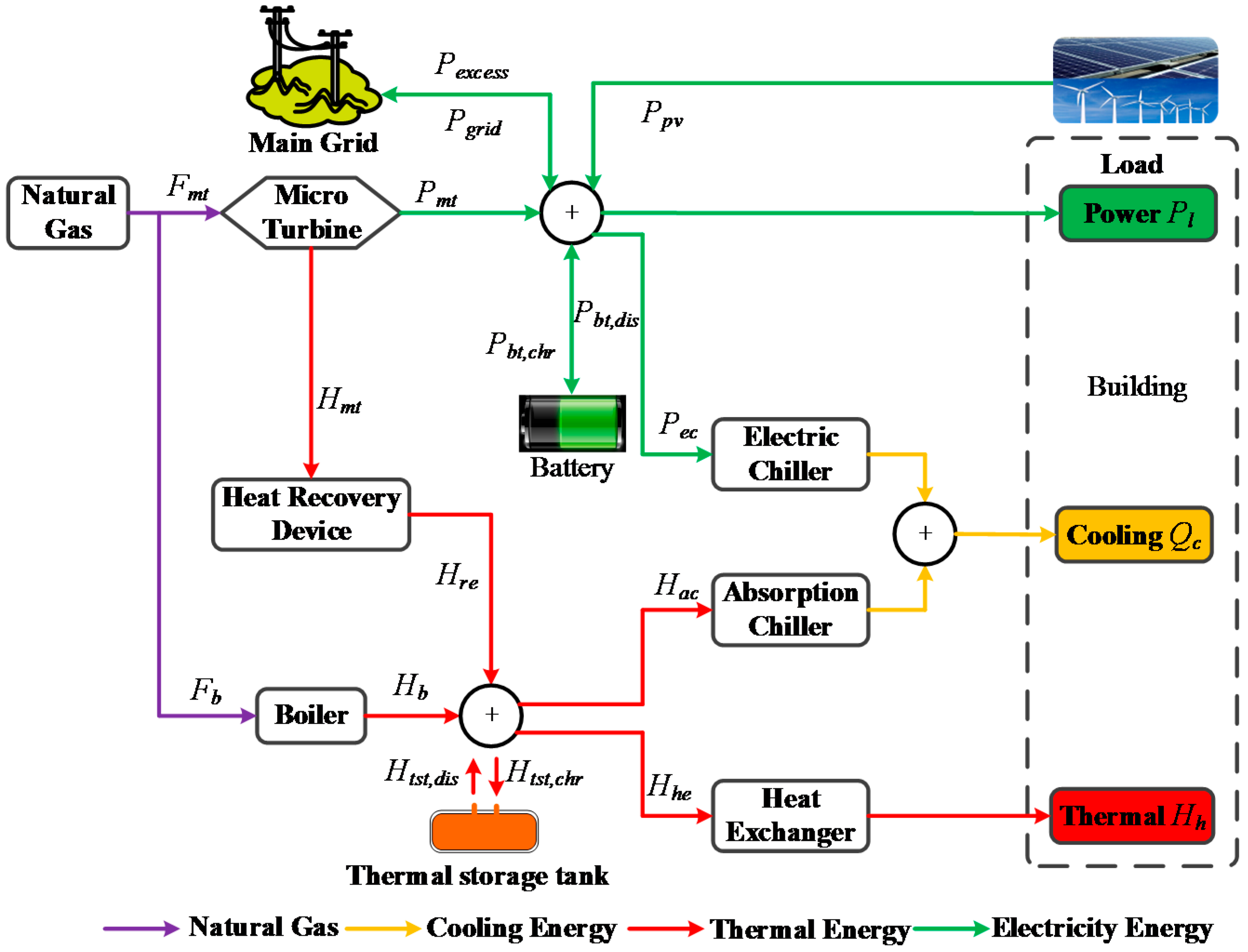
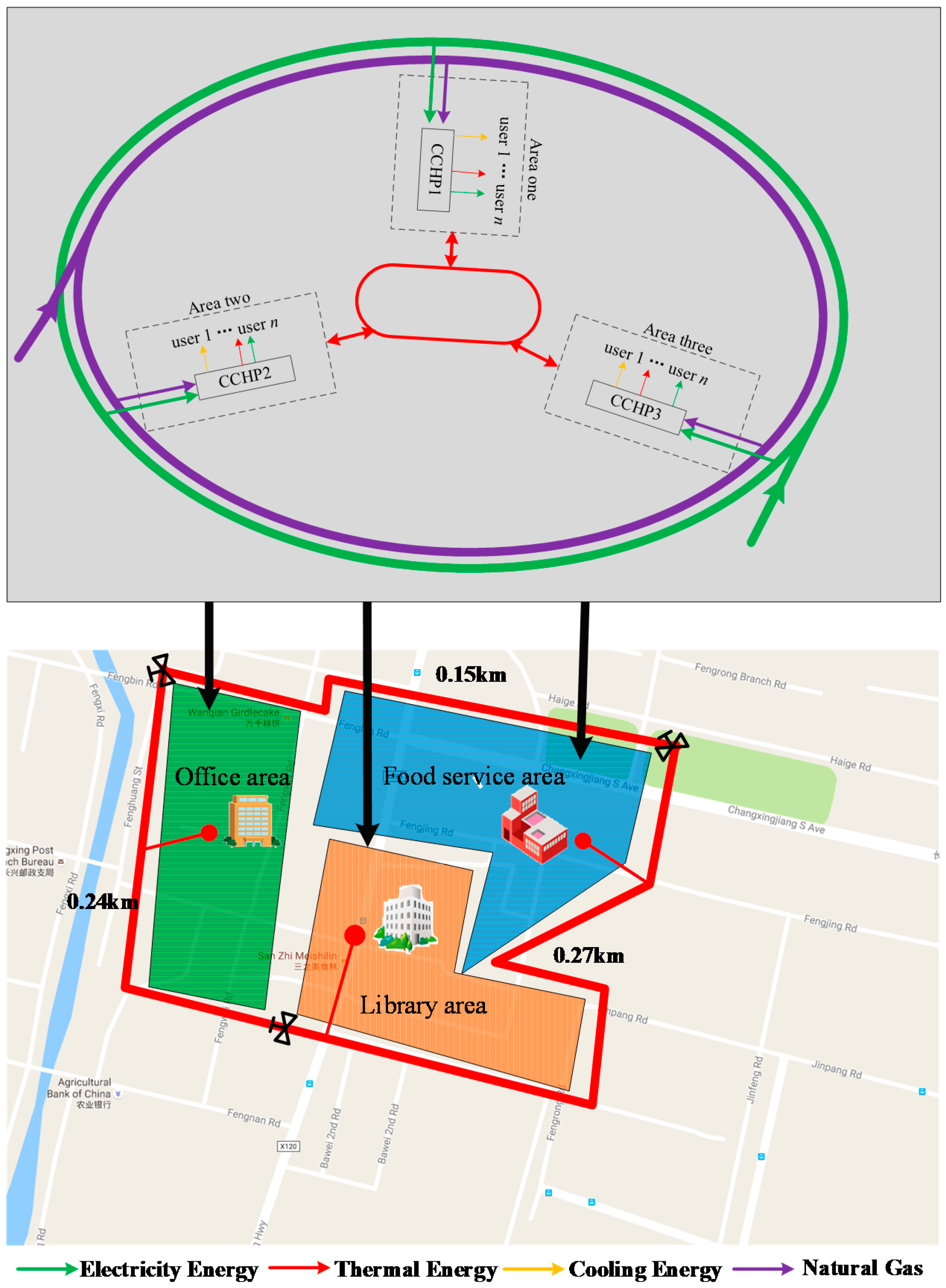

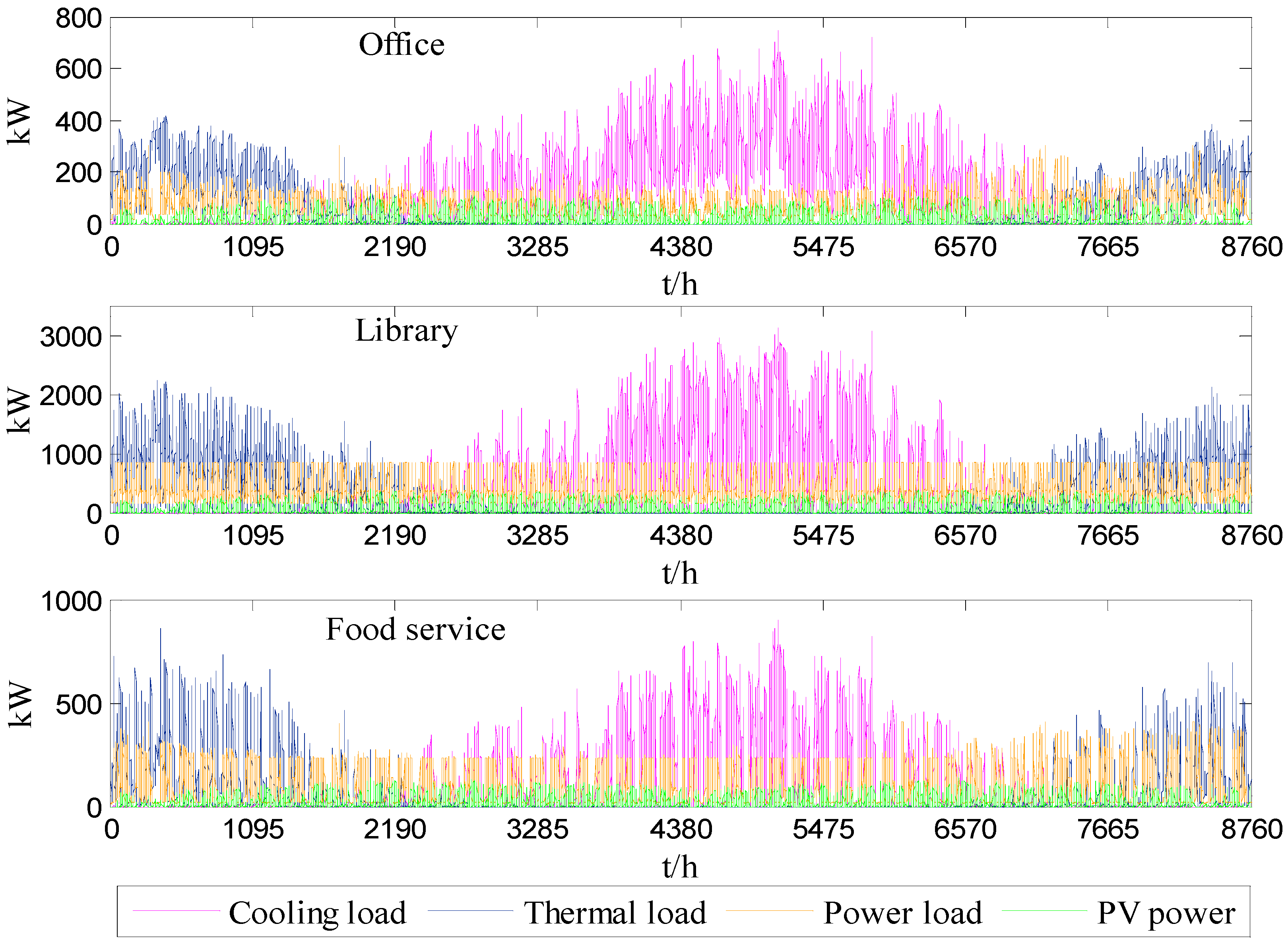
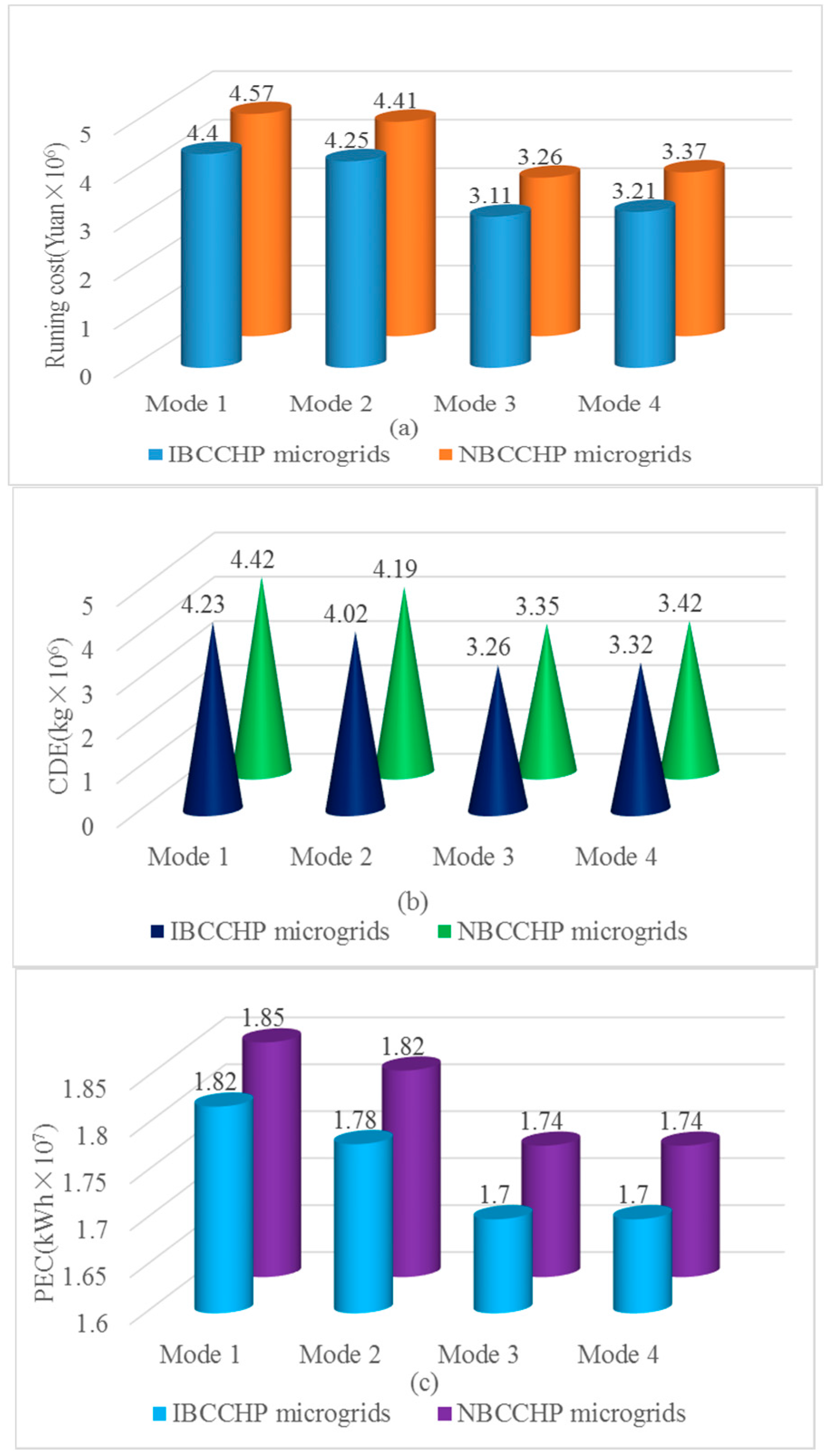

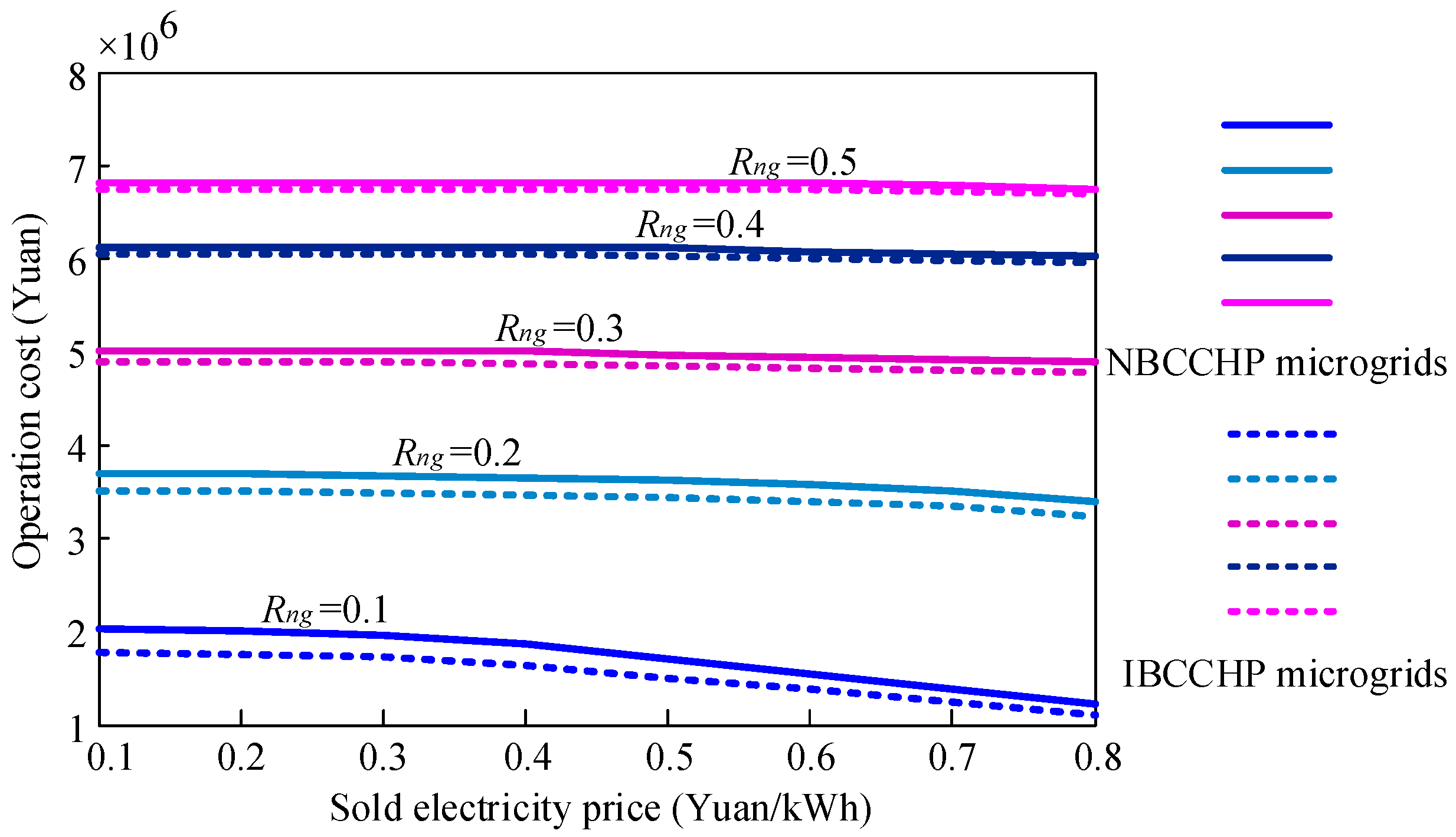
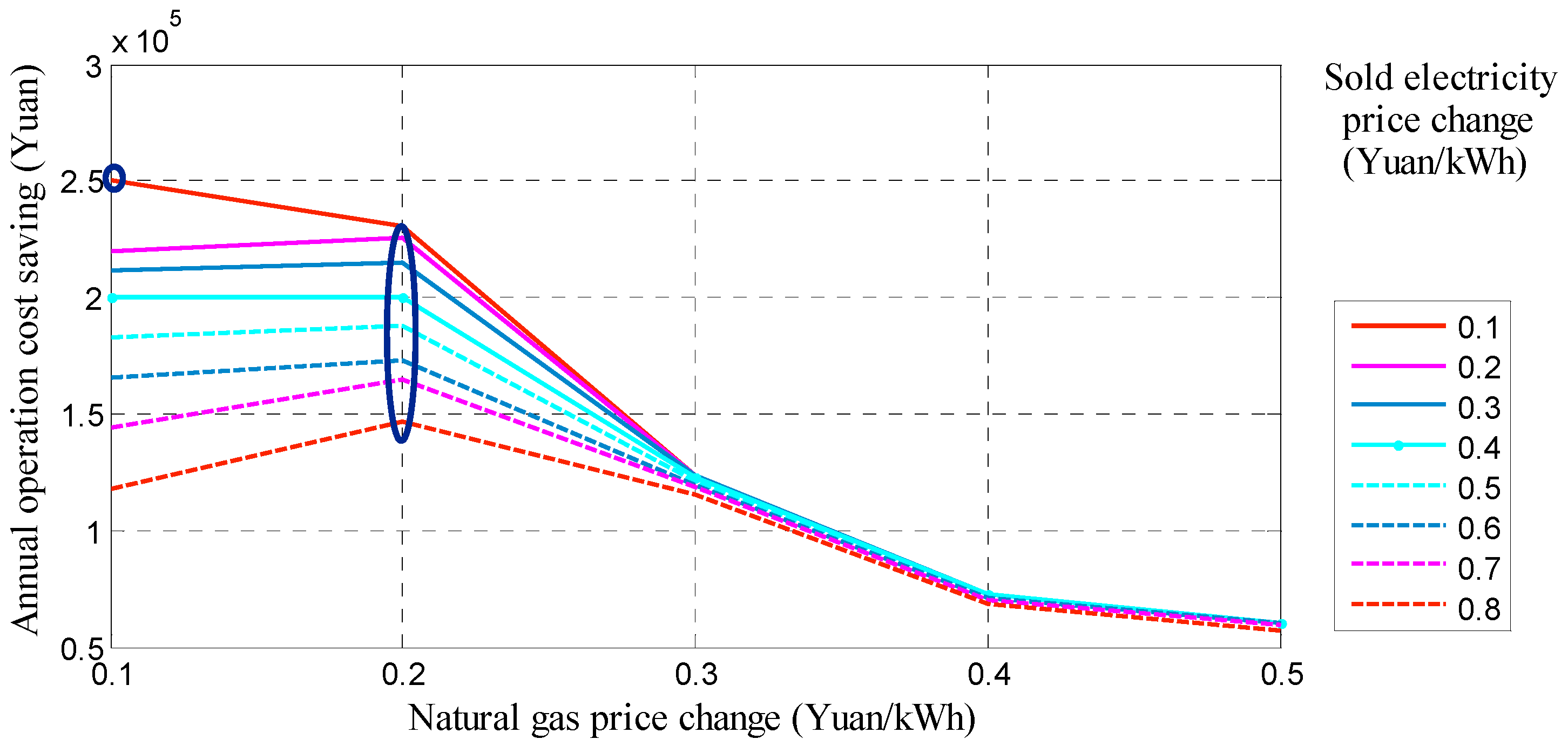
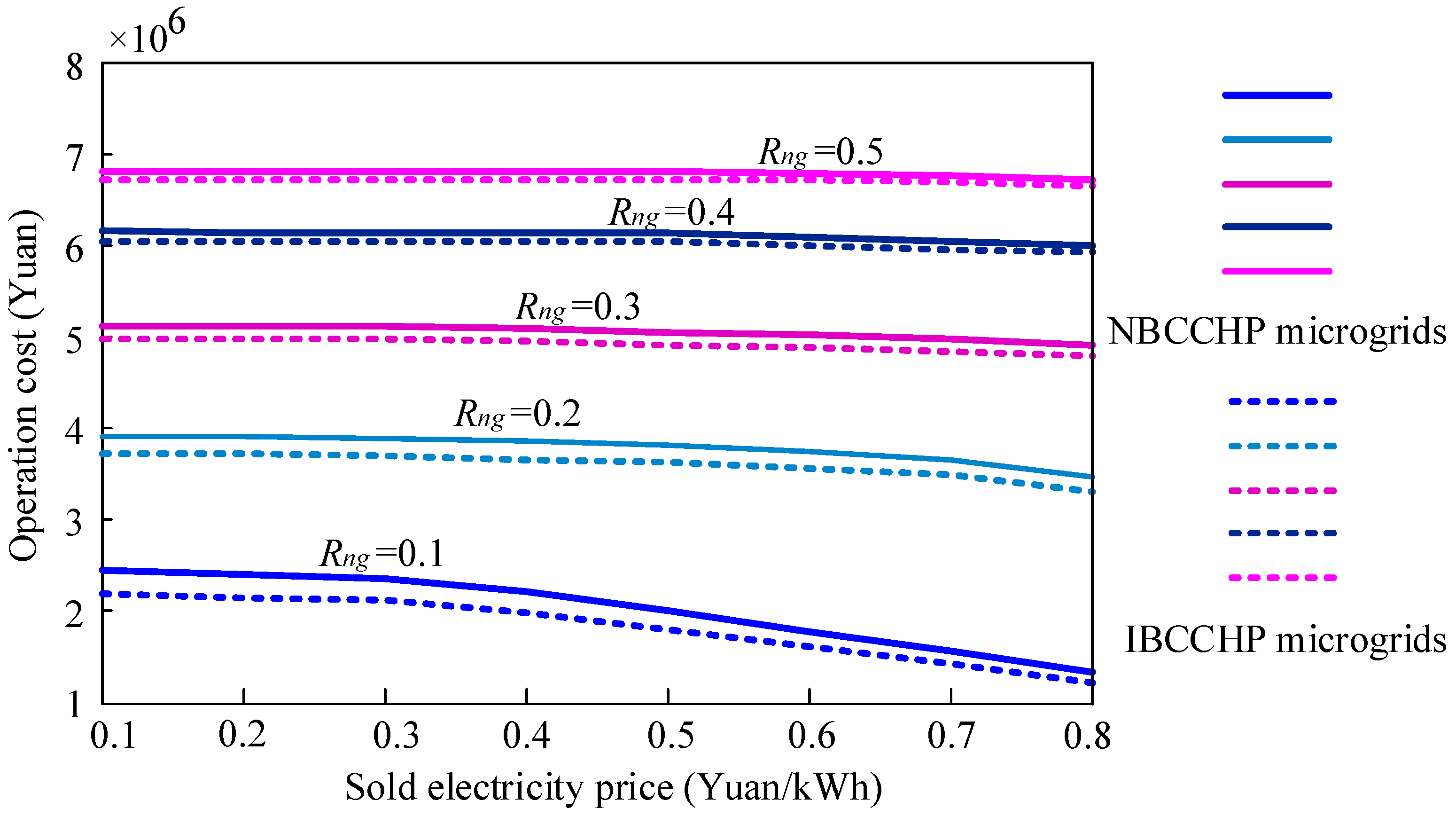
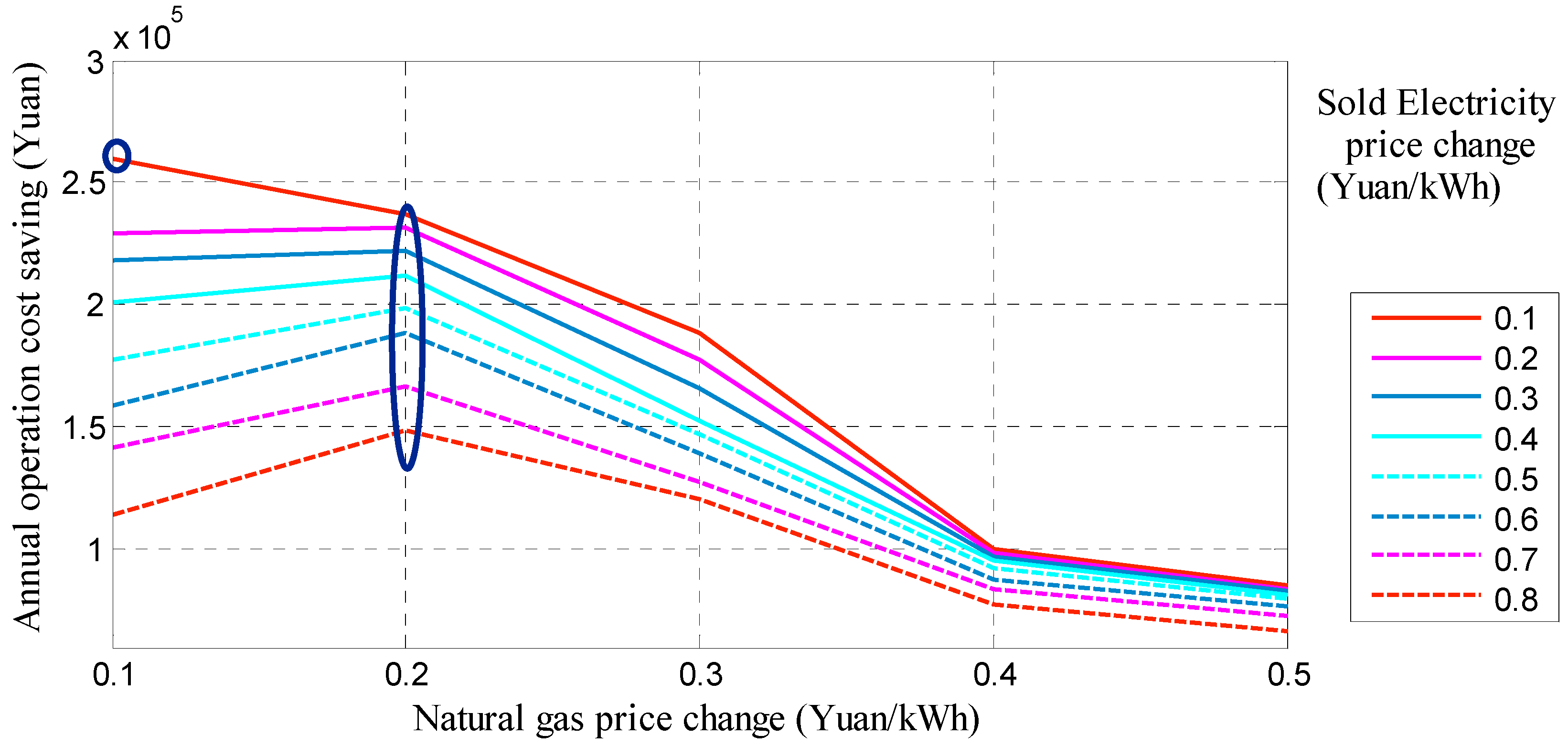
| PV | MT | ||||
|---|---|---|---|---|---|
| Sell by Subsidy | Sell by Sold Electricity Price | No Sell | Sell by Sold Electricity Price | No Sell | |
| Mode 1 | √ | √ | |||
| Mode 2 | √ | √ | |||
| Mode 3 | √ | √ | |||
| Mode 4 | √ | √ | |||
| Time | Purchase Price (Yuan/kWh) | Sell Price (Yuan/kWh) | |
|---|---|---|---|
| Peak Load Period | 8:00–10:59 | 1.231 | 0.6432 |
| 13:00–14:59 | |||
| 18:00–20:59 | |||
| Flat Load Period | 6:00–7:59 | 0.777 | 0.6432 |
| 11:00–12:59 | |||
| 15:00–17:59 | |||
| 21:00–21:59 | |||
| Off-peak Load Period | 22:00–5:59 | 0.288 | 0.6432 |
| Parameters | Value | Parameters | Value |
|---|---|---|---|
| α, β | 2.67, 11.43 | 0 | |
| ηb | 0.73 | 500 kW | |
| ηhr | 0.75 | 0 | |
| ηhe | 0.9 | 200 kW | |
| COPec | 4 | 0 | |
| COPac | 0.7 | 40 kW | |
| 0.95 | 0 | ||
| 0.95 | 40 kW | ||
| σbt | 0.02 | 40 kW | |
| 0.9 | 180 kW | ||
| 0.9 | 0 | ||
| σtst | 0.1 | 100 kWh | |
| Rng | 3.24 Yuan/m3 | Rbt | 18 Yuan/per time |
| Hng | 9.78 kWh/m3 | , | 60 kWh |
| 30 kWh | 60 kWh | ||
| ke | 3.336 | 968 g/kWh | |
| kf | 1.047 | μf | 220 g/kWh |
| Office Area (kW) | Library Area (kW) | Food Service Area (kW) | |
|---|---|---|---|
| MT | 120 | 135 | 200 |
| Gas boiler | 500 | 400 | 800 |
| Electric chiller | 150 | 100 | 200 |
| Absorption chiller | 500 | 500 | 800 |
| Heat exchangers | 500 | 600 | 900 |
| Battery | 200 | 200 | 200 |
| Heat Recovery System | 500 | 450 | 1000 |
| Exchange power with the main grid | 300 | 300 | 300 |
| PV | 130 | 150 | 200 |
© 2016 by the authors; licensee MDPI, Basel, Switzerland. This article is an open access article distributed under the terms and conditions of the Creative Commons Attribution (CC-BY) license (http://creativecommons.org/licenses/by/4.0/).
Share and Cite
Luo, Z.; Gu, W.; Sun, Y.; Yin, X.; Tang, Y.; Yuan, X. Performance Analysis of the Combined Operation of Interconnected-BCCHP Microgrids in China. Sustainability 2016, 8, 977. https://doi.org/10.3390/su8100977
Luo Z, Gu W, Sun Y, Yin X, Tang Y, Yuan X. Performance Analysis of the Combined Operation of Interconnected-BCCHP Microgrids in China. Sustainability. 2016; 8(10):977. https://doi.org/10.3390/su8100977
Chicago/Turabian StyleLuo, Zhao, Wei Gu, Yong Sun, Xiang Yin, Yiyuan Tang, and Xiaodong Yuan. 2016. "Performance Analysis of the Combined Operation of Interconnected-BCCHP Microgrids in China" Sustainability 8, no. 10: 977. https://doi.org/10.3390/su8100977





